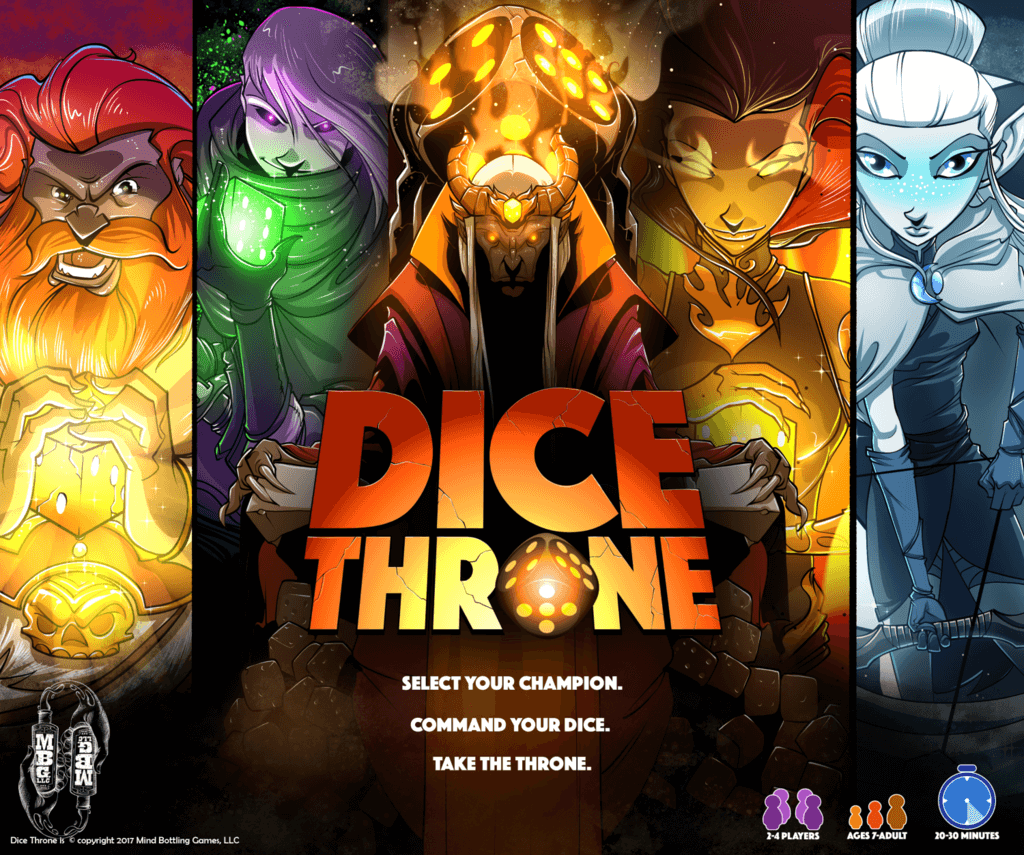The Penny Arcade Expo (also known as PAX) is one of the most popular gaming conventions in the world. With annual events in Seattle, Boston, Texas, Australia and more on the way, fans of video games have a regular cycle of gatherings they can attend. But what about board game enthusiasts?
For the first time ever, PAX Unplugged — a new convention dedicated to board games — debuted in Philadelphia in mid-November. The event was a success, to say the least.
During the 3-day outing, I got the chance to learn about, and demo first-hand, a number of new board games coming to America in the near-future, as well as a few returning favorites. I found so many new games worth recommending, in fact, that I decided to break the list up by the experience level needed to maximize the enjoyment of each. For instance, the list sorts by Casual games (those suitable for any experience level); Mid-Tier games (suitable for board game players who enjoy moderate challenges they can play in a single sitting); and Advanced games (for frequent players who enjoy multi-hour campaigns that often rely heavily on strategy and resource management).
More from Best of NJ
Casual Games
Klask
Okay, so this one’s basically cheating so we’re going to get it out of the way first. Klask isn’t really a “board game;” it’s more of a tabletop sport. In a nutshell, Klask is miniaturized air hockey with magnets. This two player game has simple rules: Each player has a magnet they hold under the table which controls their paddle; they must move their paddle to strike the ball so it rolls into the opponent’s goal.
The hitch is, there are also white “barrier” magnets that begin in the center of the court, and if two of them stick to your paddle, the other player gets a point. Also, if you lose control of your paddle and it detaches from your magnet, the other player can “capture” your paddle. In which case, your opponent gets another point. If your paddle falls into your goal, that’s another point for your opponent (so goal-tending isn’t a viable strategy). Klask is a fun and fast game that takes seconds to learn. It’s great for parties and entertaining guests.
More info: Klask was created by Mikkel Bertelsen, and typically costs $49.99.
Evolution
This one is great for families with young kids. Evolution is a card game where players get to create, adapt and protect their species from an ever-changing ecosystem while gathering food to survive. But I’m making it sound a lot more complex than it is. In reality, players draw cards that can modify their species (species are put face-down), called “Trait” cards, which give them offensive and defensive abilities. For example, you might draw a “Carnivores” card that allows you to eat other players’ species; or a “Burrowing” card that prevents you from being eaten by said Carnivores (unless they also have the Burrowing trait).
Each species can equip three unique traits, and there are eight total traits to draw, meaning there are quite a lot of potential combinations to create. The overall point of the game is to collect as much food as possible. Food is collected by feeding your species each round; but each species card can only gather one food per round (unless modified by a trait) so you’ll need a lot of different species to win. Of course, the more species you have, the harder it is to keep them all alive; and that, class, is what we call the circle of life.
More info: Evolution is published by North Star Games, and costs $39.99.
Kodama: The Tree Spirits
Last but not least in the Casual category is Kodama: The Tree Spirits. Kodama is a game built for 3-5 players that can be completed in under 45 minutes. Kodama are tree spirits and, much like the Lorax, players are charged with nurturing the trees. Each player starts with a tree base (think of it like a trunk) and spends each round selecting a single branch card to “grow” their tree into exotic and interesting shapes. Each branch card also has a random number and assortment of items on it, from stars and fireflies to worms and mushrooms; points are tallied by chaining together multiple card branches that all share the same items.
The game is broken into three “seasons,” each made up of four turns. At the end of each season, a player selects a special Kodama card (from the four they are dealt at the beginning of the game) to grant them bonus points based on the design of their tree. Kodama features gorgeous artwork, simple rules and a run time that feels fast but ultimately satisfying. It’s simple enough for young players, but has enough strategic depth to entice adults for multiple game nights.
More info: Kodama: The Tree Spirits is created by Action Phase Games and costs $19.99.
Mid-Tier Games
Dice Throne
Dice Throne begins by asking players a simple question: Are you ready to take the throne? As the story goes, a Mad King has ruled the land for a thousand years. Having grown bored with his uncontested rule, he now hosts an annual “tournament of champions” where the victor earns one of the greatest prizes imaginable; the throne. But before being allowed to challenge the king, contestants must first survive battling each other. It is in those intense moments of decisive action where the game of Dice Throne takes place.
For the base version of the game, players can select from one of six champions. Each champion has different attacks, status-changing abilities and a powerful ultimate move. Some champions, like the Barbarian and Pyromancer, favor offense while others, such as the Moon Elf and Monk, rely more heavily on status effects to hinder enemies and create opportunities for themselves. The game can be played four different ways: 1v1, 2v2, 3v3 or free-for-all. Each variation of gameplay offers a chance to utilize different strategies and tactics to win. The artwork is beautiful and the action is fast-paced. It’s easy to pick up, but takes a while to discover a winning strategy and find the champion you synergize with the most.
More info: Dice Throne was designed by Nate Chatellier & Manny Trembley, and is published by Mind Bottling Games.
Wendake
Wendake was funded through the crowdfunding service Kickstarter earlier this year. The game was available to play at PAX Unplugged prior to its full release. Wendake is proudly “Made in Italy,” and the development team is largely comprised of people who have successfully developed other popular board games across Europe. Though the board game was created by Europeans, its content is exclusively related to Native American culture.
In Wendake, players assume the role of a chief in a Native American tribe. To oversimplify the objective, you basically have to manage your tribe’s resources using your own personal board. By the end of seven rounds of gameplay, the player who was able to create and maintain the most prosperous tribe while factoring in things like economy, military strength and spiritual growth is the victor. The game works with 2-4 players, but plays best when you have a full group of four. A full game can take anywhere from 45-90 minutes, but may take a bit longer the first time around.
More info: Wendake was created by Danilo Sabia and is co-published by Placentia Games & Post Scriptum. The official retail price has not yet been announced.
Terraforming Mars: Venus Next
Most folks who are interested in or regularly play board games will have heard of Terraforming Mars. Originally released in 2015, the award-winning strategy game has since released a fair bit of additional content, including a dedicated expansion pack called Hellas & Elysium. Later this year, however, a second expansion pack is coming out. Venus Next, as it is aptly called, sends players to the planet of Venus, where they must construct flying cities while detoxing the deadly atmosphere.
The core gameplay remains largely unchanged, but for those who haven’t played the original, the basic rules are as follows: Players must manage resources while playing “project” cards they have purchased. These projects range from introducing plant and animal species to the planet, to creating atmospheric industries that can help warm it. Many cards can only be played based on certain conditions, such as the current viability of the planet’s oxygen, water supply or temperature.
More info: Both Terraforming Mars and the Venus Next expansion are designed for 2-5 players (I recommend at least 3); the expansion can be played within 90-120 minutes (the original game board is required). The Venus Next expansion is published by FryxGames and designed by Jacob Fryxelius.
Advanced Games
Bios: Megafauna (Second Edition)
The version of Bios: Megafauna on display at PAX Unplugged is known as the “second edition,” which is important to denote because it is actually a revamped version of the original. According to the game’s publisher, Sierra Madre Games, the second addition is “an evolutionary descendant of American Megafauna.” But American Megafauna is actually another game entirely and not linked to the Bios series. Instead, the second edition of Bios: Megafauna is a direct tie-in, and serves as the sequel to, Bios: Genesis. This led to certain content changes being made for the second edition. Confused? Perfect, let’s press onward.
Since Genesis left off at the beginning of the Phanerozoic eon, that’s where Megafauna begins. Players begin as a plant or animal which can evolve and mutate to suit the changing landscapes of the board. From there, the game is all about surviving and prospering despite environmental changes (such as oxygen level, cloud cover and greenhouse gasses) and competition from other players’ species.
If I’ve made any of this sound simple, I’ve done Megafauna a disservice. It’s a complex game that requires some serious effort to learn, let alone master. Games can last between 90-180 minutes; but if you’re playing for the first time, you’ll need to block out about four hours to learn everything.
More info: Bios Megafauna is available for pre-order from the Sierra Madre website and costs around $75.
A Handful of Stars
A Handful of Stars is unofficially (or rather, “unintendedly”) the final game in an ongoing trilogy. Much in the same way that Edgar Wright’s “Three Flavors Cornetto trilogy” comprises of three technically unrelated films; A Handful of Stars succeeds both A Few Acres of Snow and Mythotopia in what players refer to as the “A Few Acres of Snow trilogy.” (All three games share some core mechanics.) The premise is the empire of Arm was suddenly and inexplicably torn from its world and scattered among the stars. Now, the factions of Arm must find a way to reunite and rebuild.
Every time you play, the board layout is random. Certain tiles contain star systems — which further subdivide into habitable and uninhabitable — while others contain black holes. Uninhabitable systems may sound like a bum deal, but they are actually rich in resources; the tradeoff is that only habitable star systems earn more points and allow players to build ships. Players then get an alien race to command, with the ultimate objective of earning more victory points than opponents. You earn points by expanding into new star systems, building outposts or developing a colony. The game takes about two hours to play, and is suitable for 2-4 players.
More info: A Handful of Stars was designed by Martin Wallace and originally published by Treefrog Games. (The US distributor for reprints and new editions is Grey Fox Games). It typically costs $69.99.
Hero (Top) Photos: © Vinny Parisi / Best of NJ
Other Photos (in Order):
Klask / Website
Dice Throne Box Art / Website














